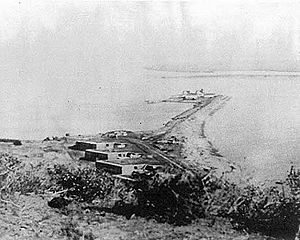Fort Guijarros facts for kids
Quick facts for kids Fort Guijarros |
|
|---|---|

San Diego Bay, California. “Battery (ruined)”; Enlarged detail of the tracing on the plan table sheet of San Diego Bay, California. Survey by A.M. Harrison. Source: U.S. Coast Survey, 1851.
|
|
| Location | Ballast Point, San Diego, California |
| Reference no. | 69 |
| Designated | November 6, 1980 |
| Reference no. | 27 |
Fort Guijarros was an old Spanish fort in San Diego, California. Its name means "Fort Cobblestones" in English. The Spanish built it in 1797 on Ballast Point. It was the first fort to protect San Diego Bay.
This fort was part of a sea battle called the Battle of San Diego. It fought against an American trading ship. Today, it is a special historical place, known as California Historical Landmark #69.
Contents
What Was Fort Guijarros Like?
Fort Guijarros was built from adobe, which is a type of sun-dried brick. It had ten powerful cannons ready to defend the bay.
Two of these original cannons still exist today. One cannon, named "El Jupiter," is now at the San Diego History Center. Another, called "El Capitan," can be found in San Diego Viejo Plaza.
Where Was the Fort Located?
The fort was built in 1797 to guard the entrance to San Diego Bay. It sat on a small hill at the base of Ballast Point, near Point Loma.
In 1796, the Spanish called this spot "Punta de los Guijarros." This means "point of the cobblestones." That's why the fort's English name is "Fort Cobblestones."
Ballast Point got its name from early American sailors. They would collect stones from this point. These stones were used as ballast in their ships. Ballast helped keep their ships stable on long journeys back home.
Exciting History of Fort Guijarros
The ten cannons of Fort Guijarros were fired in battle only two times. Both times, they were aimed at American ships.
The Battle of San Diego (1803)
The first time the cannons fired was in 1803. This was during the Battle of San Diego. Spanish soldiers had stopped an American ship, the Lelia Byrd, in San Diego Harbor. They believed the ship was smuggling otter skins.
The ship's crew managed to overpower their Spanish guards. As they tried to sail out of the harbor, the fort's cannons opened fire. However, the Lelia Byrd fired back. Its shots forced the fort's gunners to take cover, and the ship escaped.
Later Battles and Changes
The fort fired its cannons again in 1828. This time, the fort was under Mexican control. The target was another American ship, the Franklin, which was also suspected of smuggling.
In 1846, during the Mexican American War, American Marines landed nearby. They took abandoned cannons from Fort Guijarros. They then used these cannons to attack Old Town San Diego.
Ballast Point Today
In 1873, the United States Army took over Ballast Point. They built new gun batteries there to defend San Diego. This area became known as Fort Rosecrans. These defenses were used through World War I and World War II.
A lighthouse called the Ballast Point Light was built in 1890. It stood until 1957. In 1962, the United States Navy built a submarine base on Ballast Point. This base became home to the Pacific Fleet's nuclear attack submarines.
Today, the Fort Guijarros Museum Foundation studies the history of Ballast Point. They conduct archaeological digs and research.



